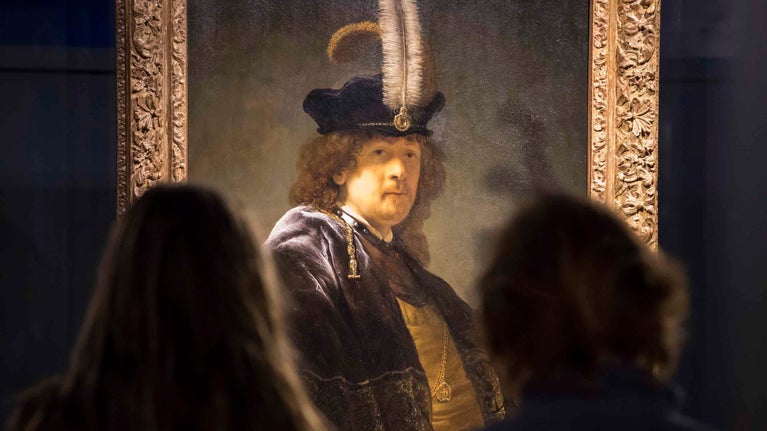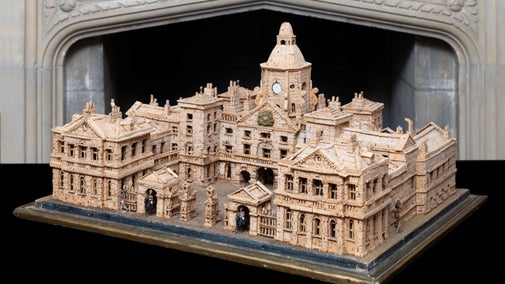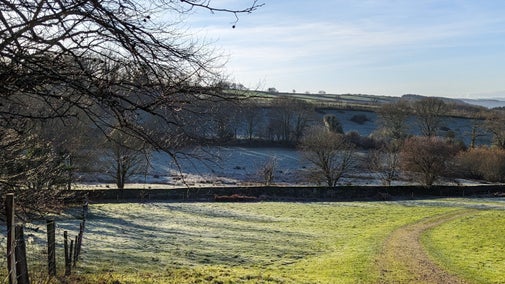
Buckland Abbey's collections
Explore the objects and works of art we care for at Buckland Abbey on the National Trust Collections website.

More than 350 years after Rembrandt's death, an oil painting at Buckland Abbey was scientifically verified as a genuine 17th-century ‘selfie’. It’s now on display in the Georgian Dining Room.
Buckland's Rembrandt self portrait is away on tour to other National Trust properties at the moment. If you want to catch the painting in one of the temporary locations, it will be at: Kingston Lacy - 12 September 2025 to 16 November 2025. It returns after Christmas from 12th January to 22 March 2026; Dunham Massey- 27 March to 12 July 2026; Upton House- 17 July 2026 to 08 November 2026. A full size print of the portrait along with information about the painting and the identification process will still be available to see at Buckland Abbey.
Buckland Abbey is home to a painting called Self-Portrait Wearing a White Feathered Bonnet, dated 1635. It was believed to be ‘school of Rembrandt’, meaning it was painted by one of his students or followers.
However, in 2013, the world’s leading Rembrandt expert, Ernst van de Wetering, suggested that the piece could've been painted by the Dutch artist himself. As a result, the artwork was sent for scientific analysis.
Although I was pretty certain the painting was a Rembrandt, I wanted to further examine it after cleaning and see the results from the technical analysis, as this had never been done before.

Authenticating paintings like the self-portrait at Buckland is no easy task, and relies on three aspects:
Buckland Abbey’s self-portrait was sent to the Hamilton Kerr Institute (HKI) in Cambridgeshire. Here, it underwent eight months of painstaking investigation, where even the signature was analysed.
Here are six of the steps it took to confirm that the painting was a genuine Rembrandt:

Christine Slottvedd Kimbriel, HKI paintings conservator, said, ‘Careful cleaning and removal of several layers of aged and yellowed varnish revealed the original colours and painting style beneath, which was much more detailed and gave a three-dimensional appearance to the fabric in Rembrandt’s cloak.’
David Taylor, Paintings and Sculpture Curator for the National Trust at the time, commented, ‘The key element for me has been the cleaning. The varnish was so yellow that it was difficult to see how beautifully the portrait had been painted.
'Now you can really see all the flesh tones and other colours, as well as the way in which the paint has been handled – it's now much easier to appreciate it as a Rembrandt.’
The investigation was funded by the players of the People’s Postcode Lottery, which dedicated £100,000 to the project. This covered the analysis and the much-needed conservation of the painting, as well as helping to create an exhibition at Buckland Abbey.
Rembrandt’s Self-Portrait Wearing a White Feathered Bonnet can now be found in the Georgian dining room at Buckland Abbey.

Explore the objects and works of art we care for at Buckland Abbey on the National Trust Collections website.
The art and heritage collections we care for rival the world’s greatest museums. Learn more about the collection of paintings, decorative art, costume, books, household and other objects at historic places.

See the breadth of our collection of works of art, furniture and more: we care for around a million objects at over 200 historic places, there’s a surprise discovery around every corner.

Discover the stories behind some of the greatest artworks and artefacts looked after by the National Trust, as told in a dedicated book, 125 Treasures from the Collections of the National Trust.

Discover a wealth of history at Buckland Abbey, from its time as a medieval farming monastery to the famous Tudor explorers who called it home.

Explore the abbey which is part museum, part house, and filled with treasures. Step inside the medieval Great Barn: a tithe barn unchanged since it was built centuries ago.

Discover Buckland's ancient woodland on one of three colour coded routes. With abundant wildlife and far reaching views, it's a peaceful and fascinating place to enjoy.

Take a break at the Ox Yard coffee shop, which serves tea, coffee, light lunches and sweet treats, before finding a special gift or souvenir in the National Trust shop, art galleries and second-hand bookshop.

From beautiful blooms to bountiful harvests, the gardens at Buckland Abbey are full of colour and seasonal interest. Soak up the history of this special place as you admire the planting, or simply enjoy the peace and tranquillity as you sit a while on one of the benches.
